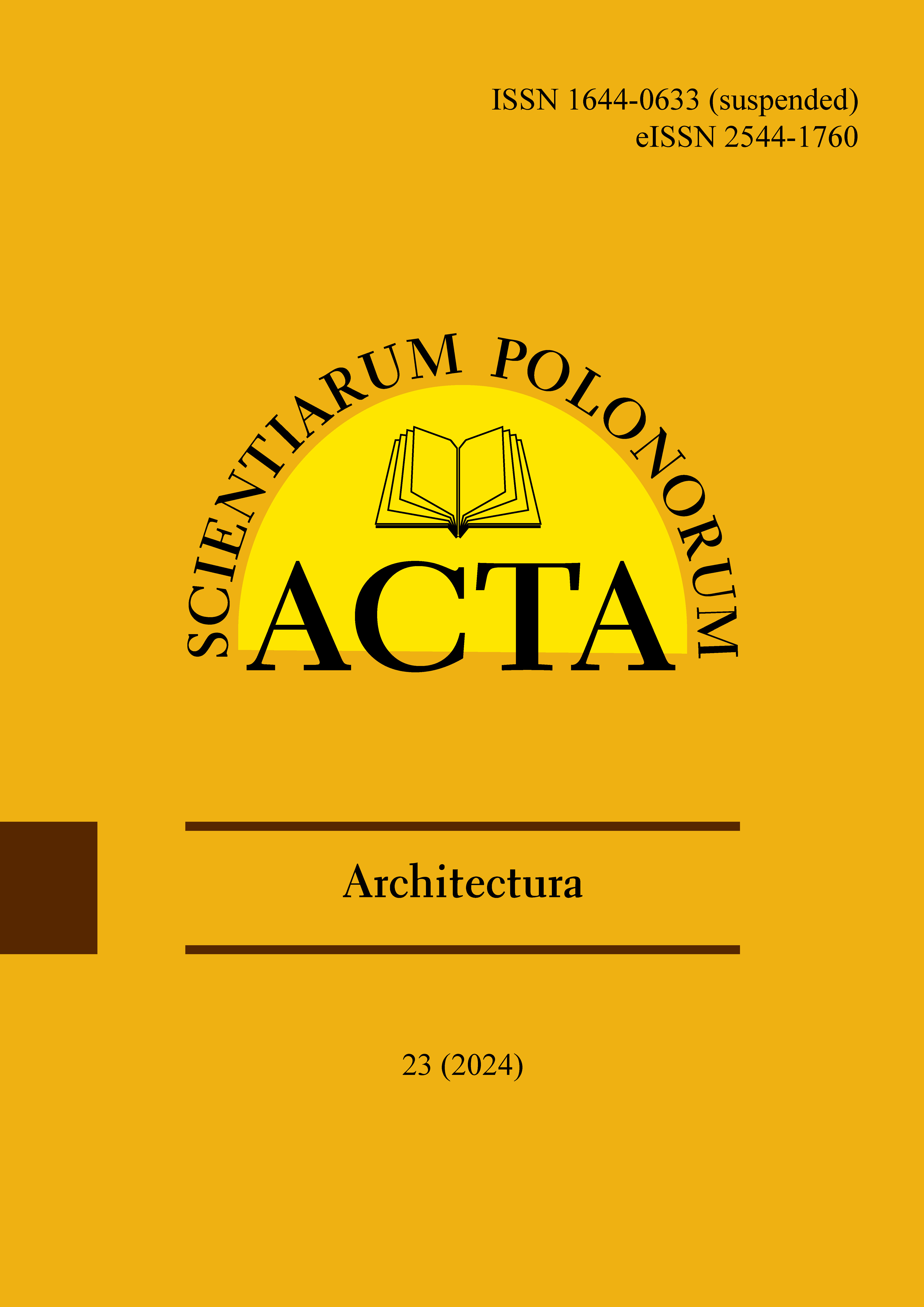Main Article Content
Some of the most significant problems of industrialised countries are increasing consumerism, the growing demand for more and more energy and other natural resources, and the depletion of non-renewable sources. The visible consequences are environmental pollution and global warming. To address these issues, there is growing pressure on the use of alternative energy sources, the use of natural resources and the introduction of new technologies. The use of multi-criteria building certification systems, which evaluate their performance, is becoming increasingly common in the building industry. The BREEAM, the LEED, and the DGNB are among the most popular methods for assessing sustainable architecture, and they project management tools. The main task of the article was to define and describe the impact of documents related to sustainable development certificates on contemporary design and living and working conditions, as well as to demonstrate the relationship between the quality of architecture and environmental protection. Another goal is to indicate how dynamically the number of certificates issued in Poland is increasing. The study used the necessary research methods: analysis and criticism of applicable documents and literature, as well as an intuitive method based on personal experience. The scope of the work includes a discussion of the most frequently obtained certificates: the BREEAM, the LEED, and the DGNB, the achievements of which prove the use of solutions conducive to sustainable development.
Article Details
Bergman, D. (2012). Sustainable Design: A Critical Guide. New York: Princeton Architectural Press.
BRE Global (2021). BREEAM International New Construction (version 6.0. Technical Manual – SD250).
Chmielewski, J. M. (2010). Teoria urbanistyki w projektowaniu i planowaniu miast. Warszawa: Oficyna Wydawnicza Politechniki Warszawskiej.
Council Directive 2003/96/EC of 27 October 2003 restructuring the Community framework for the taxation of energy products and electricity (OJ L 283, 31.10.2003, pp. 51–70).
Deutsche Gesellschaft für Nachhaltiges Bauen [DGNB], (2014). DGNB System. Excellence defined. Sustainable building with a systems approach. Stuttgart. Retrieved from: https://www.studocu.com/de-at/document/technische-universitat-wien/okologie-und-nachhaltige-entwicklung/dgnb-system-en-5-2014-web/65665176 [accessed: 20.07.2023].
Directive 2010/31/EU of the European Parliament and of the Council of 19 May 2010 on the energy performance of buildings (OJ L 153, 18.6.2010, pp. 13–35).
Drabik, L., Kubiak-Sokół, A. & Sobol, E. (2023). Słownik języka polskiego. Warszawa: Wydawnictwo Naukowe PWN. (Crossref)
Erbach, G. & Jensen, L. (2024). Fit for 55 package. European Parliamentary Research Service Parliament. Briefing. Towards climate neutrality (PE 733.513, March). European Parliament.
Eurostat (2023, December). Eurostat Statistics Explained 2021. Renewable energy statistic. Retrieved from: https://ec.europa.eu/eurostat/statistics-explained/index.php?title=Renewable_energy_statistics [accessed: 20.07.2023].
EY [n.d.]. Doradztwo i usługi prawne. Ernst & Young Global Limited. Retrieved from: https://www.ey.com/pl_pl/law/ [accessed: 20.07.2023].
Hurmekoski, E. (2017). How can wood construction reduce environmental degradation? European Forest Institute. Retrieved from: https://efi.int/sites/default/files/files/publication-bank/2018/efi_hurmekoski_wood_construction_2017_0.pdf [accessed: 20.07.2023].
Jaczewski, M. (2014). Problematyka zrównoważonego budownictwa na etapie realizacji inwestycji. Budownictwo. Technologie. Architektura, 4, 60–63.
Kamionka, L. W. (2012). Architektura zrównoważona i jej standardy na przykładzie wybranych metod oceny. Kielce: Wydawnictwo Politechniki Świętokrzyskiej.
Konstytucja Rzeczypospolitej Polskiej z dnia 2 kwietnia 1997 r. (Dz.U. 1997 Nr 78 poz. 483).
Obwieszczenie Ministra Rozwoju i Technologii z dnia 12 lipca 2022 r. w sprawie ogłoszenia jednolitego tekstu rozporządzenia Ministra Rozwoju w sprawie szczegółowego zakresu i formy projektu budowlanego (Dz.U. 2022 poz. 1679).
Pascala, S. & Socolow, R. (2019). Stabilization Wedges: Solving the Climate Problem for the Next 50 years with Current Technologies. Science, 305, 968–972. (Crossref)
Polskie Stowarzyszenie Budownictwa Ekologicznego [PLGBC], (2023a). Baza budynków. Retrieved from: https://baza.plgbc.org.pl [accessed: 20.07.2023].
Polskie Stowarzyszenie Budownictwa Ekologicznego [PLGBC], (2023b). Co to jest BREEAM? Retrieved from: https://plgbc.org.pl/zrownowazone-budownictwo/certyfikacje-wielokryterialne/breeam/#1586854563035-2052d0de-16edc446-7816 [accessed: 20.07.2023]
Polskie Stowarzyszenie Budownictwa Ekologicznego [PLGBC], (2023c). Co to jest DGNB? Retrieved from: https://plgbc.org.pl/zrownowazone-budownictwo/certyfikacje-wielokryterialne/dgnb/#1586854563035-2052d0de-16edc446-78168cdb-5cbb [accessed: 20.07.2023].
Polskie Stowarzyszenie Budownictwa Ekologicznego [PLGBC], (2023d). Co to jest LEED? Retrieved from: https://plgbc.org.pl/zrownowazone-budownictwo/certyfikacje-wielokryterialne/leed/#1586854563035-2052d0de-16edc446-78168cdb-5cbbcb29- z8dacc611-025a [accessed: 20.07.2023].
Polskie Stowarzyszenie Budownictwa Ekologicznego [PLGBC], (2023e). Zrównoważone budownictwo. Definicja. Retrieved from: https://plgbc.org.pl/zrownowazone-budownictwo/definicja/ [accessed: 20.07.2023].
Polskie Stowarzyszenie Budownictwa Ekologicznego [PLGBC], (2023f). Zrównoważone certyfikowane budynki. Raport 2023. https://plgbc.org.pl/wp-content/uploads/2023/04/Zrownowazone-certyfikowane-budynki-2023.pdf [accessed: 20.07.2023].
Runkiewicz, L. (2010). Realizacja obiektów budowlanych zgodnie z zasadami zrównoważonego rozwoju. Przegląd Budowlany, 2, 17–23. Retrieved from: https://www.przegladbudowlany.pl/2010/02/2010-02-PB-17-23_Runkiewicz.pdf [accessed: 20.07.2023]. (Crossref)
SKANSKA (2016, 6 September). Pierwszy budynek mieszkalny w Polsce oficjalnie z BREEAM. Press release. Retrieved from: https://www.skanska.pl/o-skanska/media/informacje-prasowe/173804/Pierwszy-budynek-mieszkalny-w-Polsce-oficjalnie-z-BREEAM [accessed: 20.07.2023].
Stipo, F. (2015). A standard design process for sustainable design, The 5th International Conference of Sustainable Energy Information Technology (SEIT 2015). Procedia Computer Science, 52, 746–753. (Crossref)
UNESCO, [n.d.]. Education for sustainable development. Retrieved from: https://www.unesco.org/en/sustainable-development/education [accessed 20.07.2023].
United Nations Conference on Environment and Development Rio de Janeiro, Brazil (1993). Agenda 21: programme of action for sustainable development; Rio Declaration on Environment and Development; Statement of Forest Principles: The final text of agreements negotiated by governments at the United Nations Conference on Environment and Development (UNCED), 3–14 June 1992, Rio de Janeiro, Brazil. United Nations Department of Public Information.
U.S. Green Building Council [USGBC], (2019, 25 July). LEED: Reference Guide for Building Design and Construction (v4). Washington, DC.
Ustawa z dnia 27 kwietnia 2002 r. Prawo ochrony środowiska (Dz.U. 2001 Nr 62 poz. 627).
Downloads

This work is licensed under a Creative Commons Attribution-NonCommercial 4.0 International License.


 Knowledge base
Knowledge base